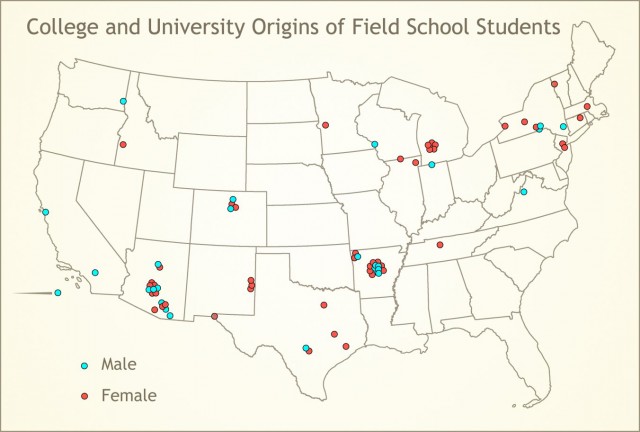- Home
- >
- Preservation Archaeology Blog
- >
- Rewarding Award

(February 25, 2016)—Jeff Clark and I recently received the happy news that our Upper Gila Preservation Archaeology Field School has received three years of student funding from the National Science Foundation’s (NSF) Research Experiences for Undergraduates (REU) program (Award 1560465). REU programs are a little different from many NSF grants in that these awards are intended primarily to support undergraduate education, specifically student participation in scientific research projects.
This will be the second time our field school has benefited from this program, which also supported students during our 2014–2015 field seasons. One of the most obvious benefits for students is a stipend to support their attendance—a pretty big consideration, as most field schools now cost around $4000. This means we are able to attract a diverse group of really excellent students despite the rising cost of field school programs.

Importantly, this includes top students from small colleges and local community colleges. Although a few such colleges (such as Pima Community College) have strong field archaeology programs, many have a very small anthropology faculty and are not able to provide extensive field and lab experiences. Attracting a mix of those top students and other excelling students from larger colleges and universities and making them members of a research team is an important path to keeping all of these students interested and engaged in research as they progress to careers in archaeology or in a wide variety of scientific and related fields.
Having a project team that includes a mix of students from different backgrounds, types of undergraduate institution, and parts of the country is great for the students, as it puts them in close quarters with people they would not otherwise have met and creates opportunities to become friends and colleagues. They encounter new ways of thinking about the world, from fellow students and from the people we meet in the rural communities where we work and on our field trips around the Southwest. We also strive for a staff with experience in cultural resource management (CRM) and academic archaeology, and we host professionals representing a variety of potential career paths as visiting lecturers during the field season.
![2014 field team in front of our experimental Salado-style room (left to right): [front row] Bill Doelle (Archaeology Southwest), Stacy Ryan (Desert Archaeology Inc.), Danielle Gilbert (Arizona State University), Erin Verbeck (Vanderbilt University), Madisen Dancer (University of Arkansas), Kaelyn Olson (University of Minnesota Morris), Hannah Zanotto (Arizona State University), Will Russell (Arizona State University), [back row] Karen Schollmeyer (Archaeology Southwest), Aaron Trumbo (University of Hawaii Maui College), Riley Duke (University of Arizona), Max Forton (Michigan State University), Lewis Borck (University of Arizona), Jacqueline Fox (Arizona State University), Leslie Aragon (Desert Archaeology Inc.), Selena Soto (Grand Valley State University), Izzy Starr (Wellesley College), Chris Davis (University of Colorado Boulder), Alex Covert (Hobart & William Smith College), Andrew Finn (Mesa Community College), [on ladder] Allen Denoyer (Archaeology Southwest).](https://www.archaeologysouthwest.org/wp-content/uploads/2016/02/2014-crew-and-adobe-640x341.jpg)
This diversity in staff and students is good for our project, and also good for the discipline, because our life and work experiences greatly influence the questions we ask and how we interpret the data we collect. For example, when Jeff Clark and I stand on a Cliff phase site together, he’s quick to spot possible locations to test for migrant enclaves, whereas the first thing to catch my eye is where to look for evidence of how the village might have grown over time—and that’s just perspectives from two people trained in different state universities in Arizona.
Methodology discussions among staff members can get very intense over things as seemingly mundane as graph paper or the benefits and pitfalls of analyzing sherds smaller than a quarter. These discussions keep me from taking things for granted and ensure that I’m always trying to find new and better ways of asking and answering research questions.
Much of our research in the Upper Gila is focused on understanding how people from several different backgrounds—including migrants from the Kayenta area, local people with connections to Mogollon traditions, and people from around the Southwest who participated in Salado traditions—were able to from lasting communities despite their differences. It’s fitting that our staff and students also come from different backgrounds and institutions as we come together for six weeks each year to form a research community. We’re delighted that this new grant will enable us to continue to attract and support a diverse group of undergraduate students.
![2015 field team and friends at San Xavier del Bac Mission (left to right): [front row] Martin DeSoto (Patronato San Xavier) and grandson, Diana Trevizo (Eastern New Mexico University), Devinne Fackelmann (Grand Valley State University), Marcy Pablo (Tohono O’odham Community College), Alexander Ballesteros (Northern Arizona University), Victoria Bowler (University of Texas El Paso), Karen Schollmeyer (Archaeology Southwest), Monica Veale (University of Texas Arlington), Stacy Ryan (Desert Archaeology Inc), [back row] Alex Norwood (Arizona State University), Alexandra Flores (Beloit College), Lindsay Shepard (Arizona State University), Anna Porter (State University of New York at Buffalo), Jeff Clark (Archaeology Southwest), Allen Denoyer (Archaeology Southwest), Barry Steinbrecher (Anthropological Research LLC), Leslie Aragon (Desert Archaeology Inc.), Aaron Wright (Archaeology Southwest), Dushyant Naresh (Vassar College), Joe Hall (Cochise College), Will Russell (Arizona State University), Connor Walsh (University of Notre Dame).](https://www.archaeologysouthwest.org/wp-content/uploads/2016/02/2015-San-Xavier-group-photo-640x427.jpg)